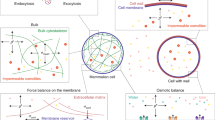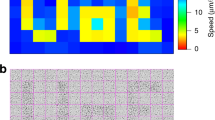Summary
Tetrahymena multiplies very rapidly up to a certain limit of population density, but growth then ceases and the number of cells becomes stationary. We report here the results of experiments using hollow spherical glass beads with a size and weight similar to those of the cells. Growth inhibition may be a result of cell-to-cell and cell-to-bead collision but not due to production of waste materials nor to exhaustion of nutrients in the medium.
Similar content being viewed by others
References
G.W. Kidder, Physiol. Zool.14, 209 (1941).
H.A. Anderson and S.J. Nielsen, J. Cell Sci.35, 17 (1979).
T. Saitoh and H. Asai, Experientia36, 1375 (1980).
D.L. Nanney and J.W. McCoy, Trans. Am. microsc. Soc.95, 664 (1976).
Author information
Authors and Affiliations
Rights and permissions
About this article
Cite this article
Saitoh, T., Asai, H. On a collision frequency restricting the growth and population density ofTetrahymena pyriformis. Experientia 38, 248–249 (1982). https://doi.org/10.1007/BF01945093
Published:
Issue Date:
DOI: https://doi.org/10.1007/BF01945093




